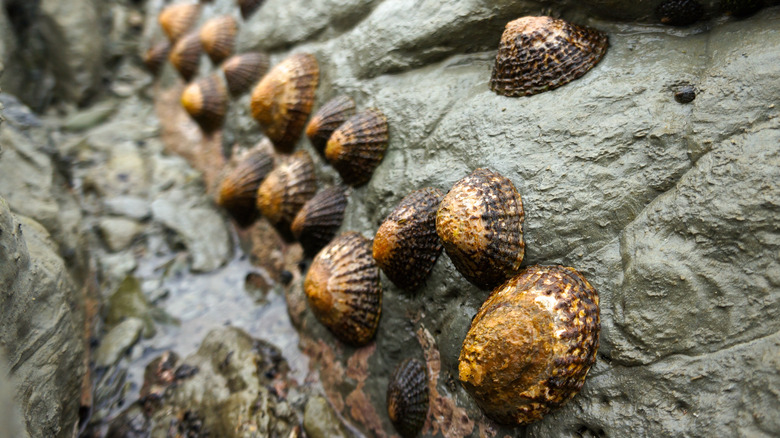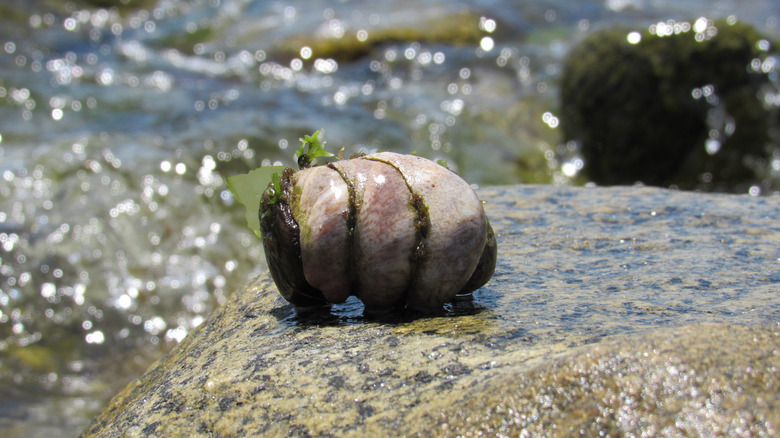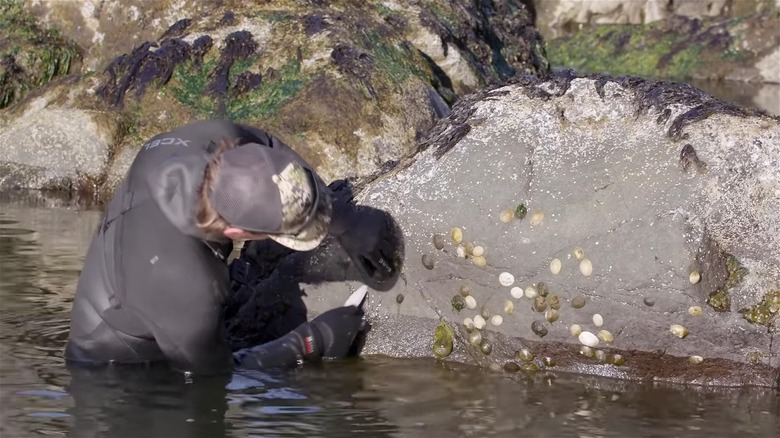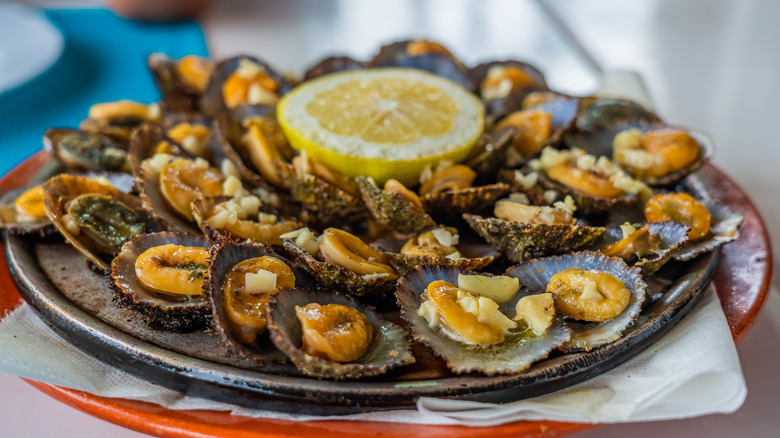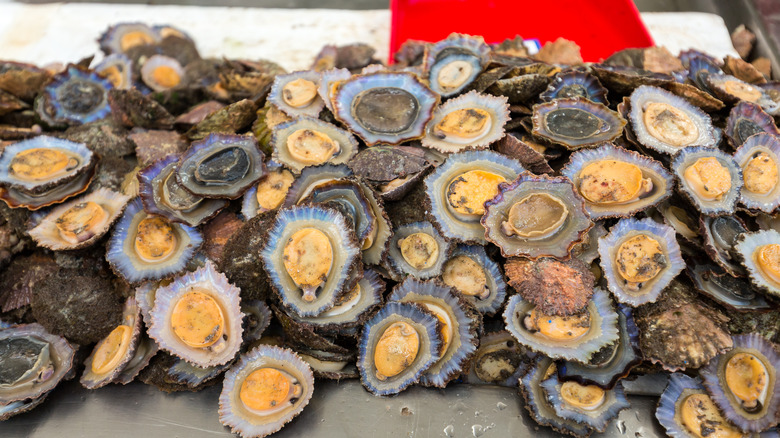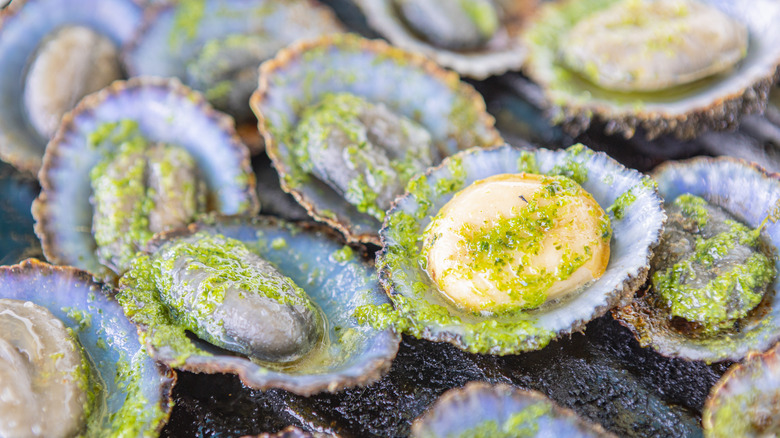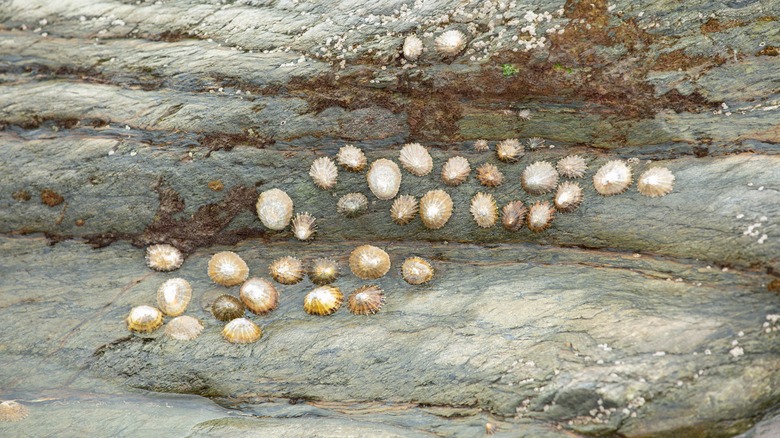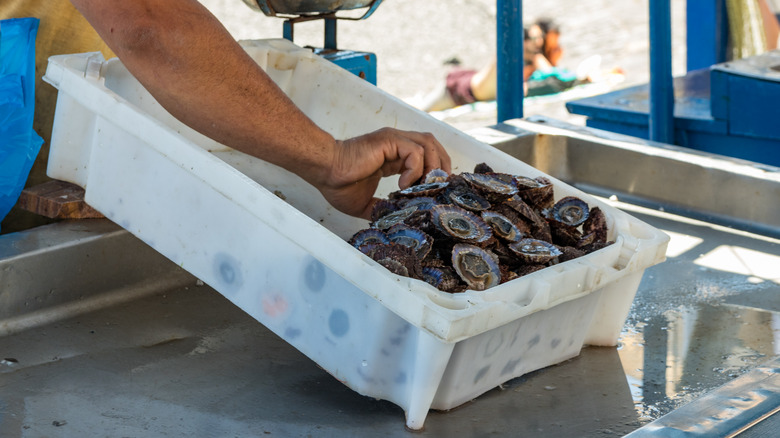What Are Limpets And Where Can You Get Them?
The phylum Mollusca accounts for over 50,000 species. Some of these, like oysters, are among the most prestigious seafoods in the world. However, another type of mollusk called limpets are not. While oysters are a highly sought-after food that conjures images of decadence, limpets are still often associated with famine and poverty and are rarely eaten in modern-day America. As a result, few Americans know where to find limpets or how to cook them.
Some people, including scientists, chefs, and survival experts, are looking to change this. These individuals are keen for humans to make the most of this dependable and nutritious food source as our ancestors did in the past. They are making some progress; limpets are showing up more often on some of America's restaurant menus, and one species was even added as a food option at one point at Google's employee cafeterias.
With public opinion on limpets shifting, we have put together a guide on the mollusk. In it we cover everything you need to know about this largely untapped food source, including where to find it and how nutritious it is.
What are limpets?
Limpets are aquatic snails that often live in intertidal zones. Their bodies are covered by large, hard shells, and many species are known for being sequential hermaphrodites, meaning they change sex during the course of their lives. Limpets survive the pounding surf and attacks from predators by firmly attaching themselves to rocks. When the coast is clear, the animals eat by running a tongue-like appendage, known as a radula, across the rock surface. The teeth attached to the radula are made from what's believed to be the strongest natural substance on Earth, and they easily scrape up young barnacles and vegetation.
There are many different species of limpet, including the Atlantic slipper limpet (Crepidula fornicata), which lives on the coasts of the United States and Europe, as well as the common limpet (Patella vulgata), which is found on the coastlines of Western Europe. While distinct, these limpets share similar anatomy and characteristics, including a strong foot that they use to grip onto rocky outcrops. Atlantic slipper limpets are easily identified as they grow in stacks with one limpet attached to the top of another. Other species tend to have a single, conical shell.
Because they live in intertidal zones, they must be able to survive full submersion and the complete absence of water. They are active when submerged, moving along the rocks. During low tide, they stay still, forming a seal between their body and shell. This helps them trap water and prevents them from drying out.
How are they caught?
Due to their low demand, limpets are usually foraged instead of farmed, and they can be easily found on many coastlines in the United States. They are collected at low tide when the limpets are exposed and not moving. The secret to harvesting limpets is to approach them quietly and tease them from the rock with the tip of a knife or with a swipe of a rock before they are aware of danger. Failure to do so will make detaching them impossible, as chef and forager Jacob Harth explained to Eater: "You have to sneak up on these things, clip them off the rock before they know you're there, otherwise they'll clamp down, and they're really hard to get off without breaking the shell, which we're totally trying to avoid ... otherwise you're just going to kill it."
Such a description makes harvesting limpets sound easy, and in some circumstances it is. However, in places like Hawaii, harvesting limpets is extremely dangerous due to the proximity of their habitat to strong waves and currents. Between 2013 and 2022, 16 people died in Hawaii while harvesting limpets, according to SFGate. This makes the mollusk one of the deadliest animals in Hawaii's waters.
The feasibility of farming limpets is debated, with some scientists in Hawaii claiming trials have proved it possible. However, others claim there has not been enough research into the area. If limpets achieve greater popularity, farming will almost certainly become an option.
Which cuisines prize limpets?
While ancient cultures from around the world used to enjoy limpets with regularity, they have been eschewed by many modern cultures. One place that still prizes them is Portugal, specifically the archipelago of Madeira, where they are a specialty. There, limpets are often grilled in their shells before being topped with butter and garlic. Because of their small size and the effort required to harvest them, they are usually served as an appetizer.
In Hawaii, limpets — which are known to Hawaiians as opihi — are considered by some to be delicacy. They are usually topped with salt and seaweed before being eaten raw . Sometimes, the limpets are eaten poke style, meaning they are diced and marinated in a mixture of soy sauce and sesame oil before being served.
Other modern-day cultures have been known to adopt the limpet in times of hardship. Throughout the German occupation during World War II, English citizens living on Jersey — an island in the English Channel — ate a type of limpet stew flavored with curry powder. It has also been reported that those in Ireland and Scotland turned to the mollusk when other food sources were scarce.
Limpets versus mussels
Mussels and limpets are two mollusks that share several characteristics. Both are harvested from shorelines, and both express a similar blend of savory and sweet flavors. Furthermore, the mollusks are two forms of cheap, nutritious, and readily available seafood.
Physiologically, the two marine animals differ. Mussels are bivalves, meaning they have two shells that open on a hinge, whereas limpets are gastropods with just one shell. Furthermore, mussels hardly move, opting to filter their food from the water they take in around them. Limpets, on the other hand, move around during low tide to source food. Yet, the greatest differences between the two animals are not physiological but in many people's perception of them. Mussels have shaken off the stigma of poverty and famine and have even become a national obsession in some countries like Belgium. Limpets, on the other hand, remain an overlooked and dismissed food source.
In the United States, mussels became a widely popular food during and after World War II. Since then, they have become lauded as an incredibly sustainable food source thanks to their great nutritional profile and the fact that farming them boosts biodiversity and improves water quality. Unfortunately, limpets have yet to receive the same degree of attention even though they boast similar nutrition values and are much more sustainable than other types of popular seafood.
Where can you get limpets?
There is little commercial demand for limpets in the United States. As a result, it is difficult to find limpets in grocery stores or online. For those living on the coast, it is often easier to forage your own than to find limpets for sale. If you do plan on foraging, however, be sure to take the necessary safety precautions and always be aware of potential dangers, including those posed by the sea itself. You should check local rules for any necessary permits or restrictions. Care should also be taken not to collect too many limpets from a single area. The animals are an important part of the food chain, and depletion can negatively affect local biodiversity.
For those unwilling or unable to forage limpets, buyers are encouraged to build connections with local seafood specialists like Sea Stephanie Fish, based in Southern California. Suppliers like these often sell specialty ingredients, including limpets, at various fish markets.
To become more popular, limpets must be easier for the average home cook to use. Sarah Schumann, founder of the nonprofit Eating With the Ecosystem, highlighted this in an interview with Slate: "The yield of the meat is low, compared to the bulk of the shell. I think that the secret to making it marketable is making a pre-shucked product like they have in France." Until this time comes, however, foraging, fish markets, and specialty suppliers are an American limpet enthusiast's best bet.
How to cook with limpets
Diners should be aware that a limpet can be broken down into two parts, as Sean Barrett, owner of a company that builds programs on sustainable seafood practices, explained to Slate: "One is a suction cup disc that's kind of tough. There's a traditional, true snail body that's attached to that. ... The suction cup is (a) dense, tougher, saltier morsel. And that backside of that is a sweet, soft, delicious little scallop-tasting snail." But before being eaten or cooked, limpets should be cleaned to remove any sand or dirt. It is also advised to remove the black gut sac from the limpet if possible.
Once limpets are prepped, they are extremely versatile. When eaten raw, they taste similar to a mussel, although the texture is somewhat rubbery. As well as being enjoyed poke-style, limpets can also be used for a take on ceviche by being doused in lime juice. In terms of cooking, limpets can be grilled over hot coals. The limpets are ready when the meat comes away from the shell. Like it is with many other mollusks, the recommended accompaniment is garlic butter. Hot sauce is also an option.
More experimental chefs prefer to sous vide their limpets. This method transforms the limpets' rubbery texture into one that is firm and smooth. Others have used the limpets to make a version of dashi while some chefs have gone for a Southern approach, boiling the limpets before tenderizing, battering, and frying them.
Where can you enjoy limpets in the United States?
While limpets are not yet a common sight in American restaurants, there are some notable establishments that have served them. These include several fine dining institutions like Dan Barber's Blue Hill at Stone Barns in New York. There, limpets were served in a dish reminiscent of French escargot and were loaded with butter and garlic. Blue Hill seems a fitting venue for limpets, seeing as it is an industry leader in serving sustainable foods. However, the mollusks are not often on the menu.
In Hawaii, where limpets are viewed as a delicacy, the mollusks are frequently served in restaurants. These have included both high-end restaurants like the now shuttered Alan Wong's, which used to serve an Opihi Shooter, and more casual establishments including Young's Fish Market in Honolulu and Kapolei. Here, a quarter pound of limpets is served for $20.
Other notable chefs have cooked with limpets. For example, Thomas Keller served limpets in Parmesan custard at Per Se, and Hiroyuki Tanaka created a limpet sushi roll at his Philadelphia restaurant Zama. Neither of these chefs serves the mollusk regularly.
Nutritional information about limpets
As with many other mollusks, limpets are a healthy and nutritious food. This is thanks to their high protein content, which stands at 15 grams per three-ounce serving. It's not just a high quantity of protein that limpets boast, but high quality too. This was explained by Faye Dong, professor emerita of food science and human nutrition at the University of Illinois, in an interview with Time Magazine: "Shellfish are high-quality protein sources — just like land animals — meaning they have all the essential amino acids." Limpets are also low in fat, containing one gram per three-ounce serving. Aside from these favorable values, limpets are also rich in vitamins and minerals, especially potassium, magnesium, calcium, and vitamins A and C.
It's not all good news, however. Limpets are high in both cholesterol and sodium. A three-ounce serving contains 72 milligrams of the former and 256 milligrams of the latter. If eaten in high volumes, limpets could easily see adults exceed their daily recommended intake of both cholesterol and sodium. As such, they should be eaten in moderation.
Are limpets sustainable?
Limpets are extremely sustainable given that the species, particularly the Atlantic slipper limpet, are prolific and remain a largely untapped food source. To make matters even better, controlling the population of Atlantic slipper limpets helps other mollusks — predominantly bivalves — thrive. This is because the Atlantic slipper limpet is an invasive species in Europe, and its growth negatively affects local oysters and clams. In France, attempts to limit the growth of slipper limpets have failed with the population growing so rapidly that mass consumption is the only possible solution.
Sarah Schumann explained how eating these prolific animals makes sense in an interview with Slate: "Eating the ecosystem is all about balancing our diets with what the ecosystem is producing. This is a species that's actually increasing. The anecdotal evidence coming from the species is that we're experiencing a surge."
It's not only their abundance that makes limpets a sustainable food option, but also their position on the food chain. While not quite at the bottom, limpets are not far from it. As 50% of energy is lost with each jump in the trophic level, eating low-lying species, like limpets, is a much more energy efficient protein than consuming higher level marine animals like salmon.
How to store limpets
If you decide to go foraging for live limpets, they should be kept in salt water, preferably with access to a food source such as seaweed until it is time to process them. Once you get home, the best thing to do is drop them into boiling water. This will kill the limpets, clean them, and make it easy for them to be removed from their shells. After boiling, the limpets can be stored in salt water and kept in the fridge until they are used. Limpets can also be stored in the freezer, although it is advised that they need to be cleaned and cooked first.
If buying fresh limpets from a supplier at a market, it is advised to bring a cool box with ice packs. This will help keep the limpets fresh during transit. Limpets that have been killed and canned or otherwise preserved do not need to be cooled. These products can be kept in the cupboard like any other canned seafood.
